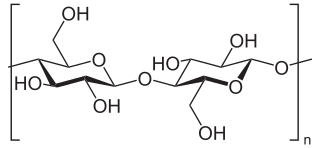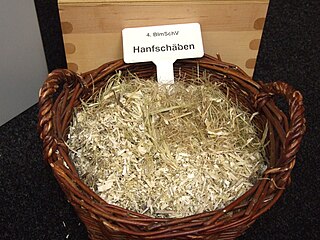
Cellulose is an organic compound with the formula (C
6H
10O
5)
n, a polysaccharide consisting of a linear chain of several hundred to many thousands of β(1→4) linked D-glucose units. Cellulose is an important structural component of the primary cell wall of green plants, many forms of algae and the oomycetes. Some species of bacteria secrete it to form biofilms. Cellulose is the most abundant organic polymer on Earth. The cellulose content of cotton fibre is 90%, that of wood is 40–50%, and that of dried hemp is approximately 57%.

Textile is an umbrella term that includes various fiber-based materials, including fibers, yarns, filaments, threads, different fabric types, etc. At first, the word "textiles" only referred to woven fabrics. However, weaving is not the only manufacturing method, and many other methods were later developed to form textile structures based on their intended use. Knitting and non-woven are other popular types of fabric manufacturing. In the contemporary world, textiles satisfy the material needs for versatile applications, from simple daily clothing to bulletproof jackets, spacesuits, and doctor's gowns.

Fiber is a natural or artificial substance that is significantly longer than it is wide. Fibers are often used in the manufacture of other materials. The strongest engineering materials often incorporate fibers, for example carbon fiber and ultra-high-molecular-weight polyethylene.

Pulp is a fibrous lignocellulosic material prepared by chemically, semi-chemically or mechanically producing cellulosic fibers from wood, fiber crops, waste paper, or rags. Mixed with water and other chemicals or plant-based additives, pulp is the major raw material used in papermaking and the industrial production of other paper products.
Wood fibres are usually cellulosic elements that are extracted from trees and used to make materials including paper.

Kenaf [etymology: Persian], Hibiscus cannabinus, is a plant in the family Malvaceae also called Deccan hemp and Java jute. Hibiscus cannabinus is in the genus Hibiscus and is native to Africa, though its exact origin is unknown. The name also applies to the fibre obtained from this plant. Kenaf is one of the allied fibres of jute and shows similar characteristics.

Fiber crops are field crops grown for their fibers, which are traditionally used to make paper, cloth, or rope.

Hemp, or industrial hemp, is a plant in the botanical class of Cannabis sativa cultivars grown specifically for industrial and consumable use. It can be used to make a wide range of products. Along with bamboo, hemp is among the fastest growing plants on Earth. It was also one of the first plants to be spun into usable fiber 50,000 years ago. It can be refined into a variety of commercial items, including paper, rope, textiles, clothing, biodegradable plastics, paint, insulation, biofuel, food, and animal feed.

The kraft process (also known as kraft pulping or sulfate process) is a process for conversion of wood into wood pulp, which consists of almost pure cellulose fibres, the main component of paper. The kraft process involves treatment of wood chips with a hot mixture of water, sodium hydroxide (NaOH), and sodium sulfide (Na2S), known as white liquor, that breaks the bonds that link lignin, hemicellulose, and cellulose. The technology entails several steps, both mechanical and chemical. It is the dominant method for producing paper. In some situations, the process has been controversial because kraft plants can release odorous products and in some situations produce substantial liquid wastes.

Manila paper is a relatively inexpensive type of paper, generally made through a less-refined process than other types of paper, and is typically made from semi-bleached wood fibers.

Kraft paper or kraft is paper or paperboard (cardboard) produced from chemical pulp produced in the kraft process.

Lignocellulose refers to plant dry matter (biomass), so called lignocellulosic biomass. It is the most abundantly available raw material on the Earth for the production of biofuels. It is composed of two kinds of carbohydrate polymers, cellulose and hemicellulose, and an aromatic-rich polymer called lignin. Any biomass rich in cellulose, hemicelluloses, and lignin are commonly referred to as lignocellulosic biomass. Each component has a distinct chemical behavior. Being a composite of three very different components makes the processing of lignocellulose challenging. The evolved resistance to degradation or even separation is referred to as recalcitrance. Overcoming this recalcitrance to produce useful, high value products requires a combination of heat, chemicals, enzymes, and microorganisms. These carbohydrate-containing polymers contain different sugar monomers and they are covalently bound to lignin.
Chiengora, also called "dog wool," is yarn or wool spun from dog hair. The word is a portmanteau of chien and angora and was coined by an American spinner, Annette Klick. Dog hair is up to 80% warmer than wool and is not elastic.
Cotton paper, also known as rag paper or rag stock paper, is made using cotton linters or cotton from used cloth (rags) as the primary material. Prior to the mid-19th century, cotton paper was the main form of paper produced, with pulp paper replacing cotton paper as the main paper material during the 19th century. Although pulp paper was cheaper to produce, its quality and durability is significantly lower. Although pulp-paper quality improved significantly over the 20th century, cotton paper continues to be more durable, and consequently important documents are often printed on cotton paper. Different grades of cotton paper can be produced.

A mixiote is a traditional pit-barbecued meat dish in central Mexico; especially in the Basin of Mexico, in which the meat is cooked inside a wrapper, traditionally in the outer skin of an agave leaf.

Bamboo textile is any cloth, yarn or clothing made from bamboo fibres. While bamboo was historically used only for structural elements, such as bustles and the ribs of corsets, in recent years various technologies have been developed that allow bamboo fibre to be used for a wide range of textile and fashion applications.

Cellulose fibers are fibers made with ethers or esters of cellulose, which can be obtained from the bark, wood or leaves of plants, or from other plant-based material. In addition to cellulose, the fibers may also contain hemicellulose and lignin, with different percentages of these components altering the mechanical properties of the fibers.
Wood-free paper is paper created exclusively from chemical pulp rather than mechanical pulp. Chemical pulp is normally made from pulpwood, but is not considered wood as most of the lignin is removed and separated from the cellulose fibers during processing, whereas mechanical pulp retains most of its wood components and can therefore still be described as wood. Wood-free paper is not as susceptible to yellowing as paper containing mechanical pulp. Wood-free paper offers several environmental and economic benefits, including reduced deforestation, decreased energy consumption, and improved waste management. The term Wood-free paper can be rather misleading or confusing for someone unfamiliar with the papermaking process because paper is normally made from wood pulp derived from trees and shrubs.

Shives, also known as shoves, boon or hurd, are the wooden refuse removed during processing flax, hemp, or jute, as opposed to the fibres (tow). Shives consist of "the woody inner portion of the hemp stalk, broken into pieces and separated from the fiber in the processes of breaking and scutching" and "correspond to the shives in flax, but are coarser and usually softer in texture". Shives are a by-product of fiber production.
Hemp paper is a paper variety consisting exclusively or to a large extent from pulp obtained from fibers of industrial hemp. The products are mainly specialty papers such as cigarette paper, banknotes and technical filter papers. Compared to wood pulp, hemp pulp offers a four to five times longer fibre, a significantly lower lignin fraction as well as a higher tear resistance and tensile strength. Because the paper industry's processes have been optimized for wood as the feedstock, production costs currently are much higher than for paper from wood.













